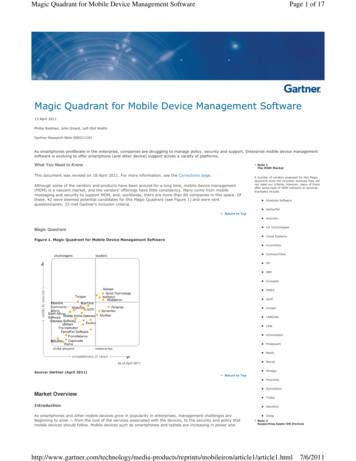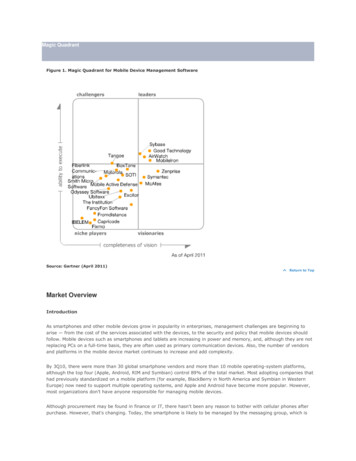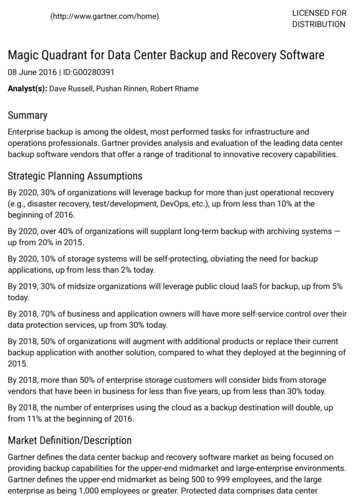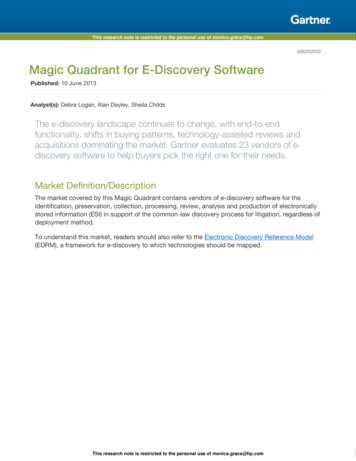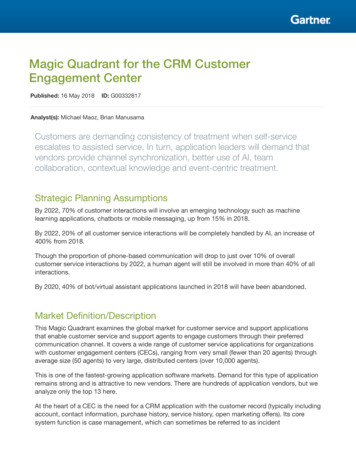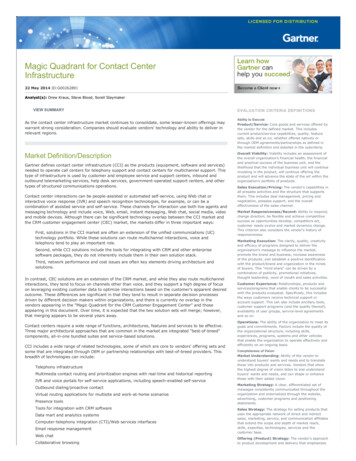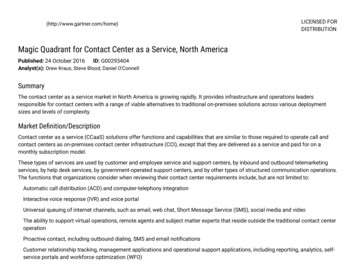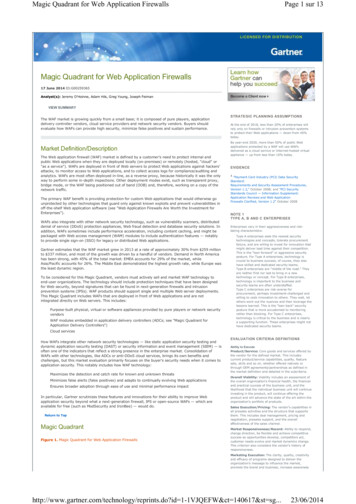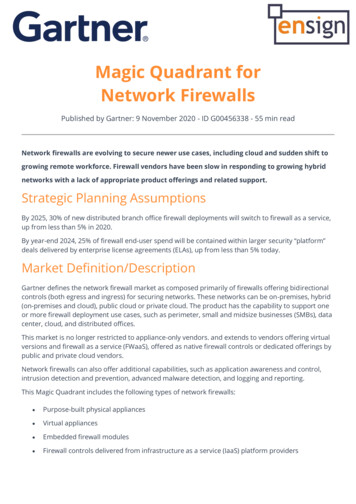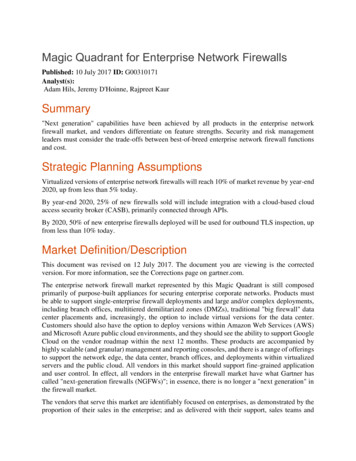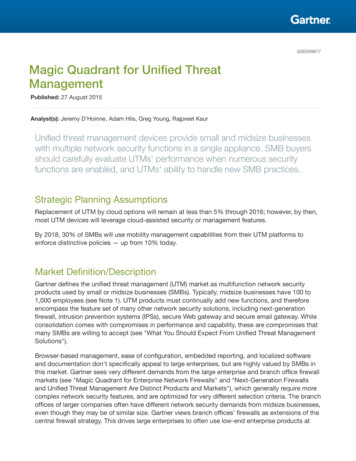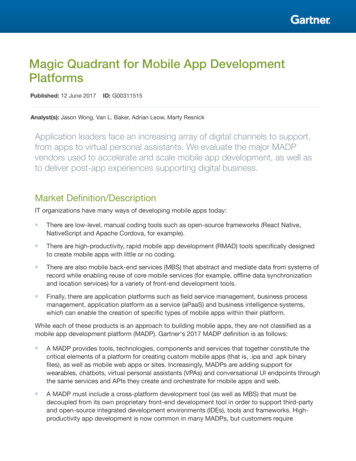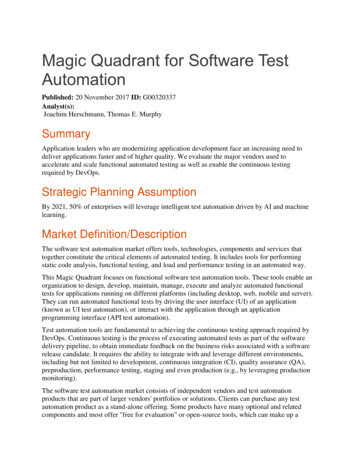
Transcription
Magic Quadrant for Software TestAutomationPublished: 20 November 2017 ID: G00320337Analyst(s):Joachim Herschmann, Thomas E. MurphySummaryApplication leaders who are modernizing application development face an increasing need todeliver applications faster and of higher quality. We evaluate the major vendors used toaccelerate and scale functional automated testing as well as enable the continuous testingrequired by DevOps.Strategic Planning AssumptionBy 2021, 50% of enterprises will leverage intelligent test automation driven by AI and machinelearning.Market Definition/DescriptionThe software test automation market offers tools, technologies, components and services thattogether constitute the critical elements of automated testing. It includes tools for performingstatic code analysis, functional testing, and load and performance testing in an automated way.This Magic Quadrant focuses on functional software test automation tools. These tools enable anorganization to design, develop, maintain, manage, execute and analyze automated functionaltests for applications running on different platforms (including desktop, web, mobile and server).They can run automated functional tests by driving the user interface (UI) of an application(known as UI test automation), or interact with the application through an applicationprogramming interface (API test automation).Test automation tools are fundamental to achieving the continuous testing approach required byDevOps. Continuous testing is the process of executing automated tests as part of the softwaredelivery pipeline, to obtain immediate feedback on the business risks associated with a softwarerelease candidate. It requires the ability to integrate with and leverage different environments,including but not limited to development, continuous integration (CI), quality assurance (QA),preproduction, performance testing, staging and even production (e.g., by leveraging productionmonitoring).The software test automation market consists of independent vendors and test automationproducts that are part of larger vendors' portfolios or solutions. Clients can purchase any testautomation product as a stand-alone offering. Some products have many optional and relatedcomponents and most offer "free for evaluation" or open-source tools, which can make up a
significant percentage of a vendor's user base. We also note that many testing service providershave a test automation offering (see "Magic Quadrant for Application Testing Services,Worldwide" ); however, these are generally not offered independently of services.Over the years, a number of independent vendors in this space have been acquired by largervendors, which demonstrates the criticality of automated testing in many enterprise systems.However, there are still dozens of independent vendors, as well as new vendors entering themarket and established vendors transforming their products to offer enhanced test automationcapabilities. Gartner expects the test automation space to continue to evolve rapidly; wearables,bots and conversational UI channels need to be folded into the omnichannel approach of modernapplications, and the increased adoption of DevOps demands higher levels of automation. Thiswill further increase the need for automated testing across a broad range of platforms andtechnologies.Open source continues to have a strong impact upon the market. Currently, open-sourcesolutions are mainly oriented toward developers and focused on web and mobile technologies,making them somewhat specialized and not appropriate for all testing needs. We expect thatmost organizations will utilize more than one solution for the next five years. We also expect thatopen source will be a core element of a growing amount of cloud-delivered test automationservices.Magic QuadrantFigure 1. Magic Quadrant for Software Test Automation
Source: Gartner (November 2017)Vendor Strengths and CautionsCA TechnologiesCA Technologies is in the Visionaries quadrant based on its vision for DevOps, shift-left testingand continuous testing. Its automated testing portfolio has evolved to address the different phasesof software delivery, including plan, build, test, release and operate, and it supports agile andlean development practices.
CA's test automation offering consists of several products, including CA Agile RequirementsDesigner for test design and generation, CA Service Virtualization (SV)/Application Test for onpremises test execution, and CA BlazeMeter for SaaS-based testing. There is an integration withCA Test Data Manager for creating and provisioning test data. Test cases can be generated witha visual modeling paradigm using different path options, a risk-based approach or by recordinglive scenarios. By default the generated test cases are manual. However, test scripts can begenerated using configuration files and code snippets for different execution engines, such as CAApplication Test, Selenium, Ranorex or Testplant, as well as the Taurus open-source testingframework. There are integrations with CI tools such as Jenkins and CA Continuous DeliveryDirector, which orchestrates continuous testing and delivery.CA offers test automation using a framework-driven paradigm. It supports testing for a widerange of technologies, including desktop, web and mobile, with either CA Application Test or bygenerating automation scripts for supported automation tools and open-source frameworks. Testscan be executed on cloud environments, such as Amazon Web Services or Microsoft Azure, oron local machines.STRENGTHS CA enables shift-left testing through SaaS-based, API-driven, open-source-supported toolsthat support continuous testing throughout the development life cycle. CA allows automatic and systematic generation of optimized sets of test cases and test databased on changes in the model. This offers significant advantages over creating test cases ina less systematic manner and manually maintaining existing automation sets. CA has a broad network of service and technology partners offering joint solutions anddriving CA brand awareness. Global system integrators offer CA's solutions within theirpractices, and managed service providers leverage CA's solutions to power theirsubscription-based IT services.CAUTIONS CA does not natively offer support for UI object recognition, mobile application/devicetesting or UI testing of applications that are not web-based, relying on integrations withother UI test automation tools that support these. This may result in additional license costsfor separate tools. Managing relationships with third-party asset repositories and keeping the integrity betweenrequirements, code and test in sync relies on repeated exports and imports. While CA has a strong set of products supporting continuous testing using a model-basedapproach, several of its reference customers indicated that this has not yet fully resonated.However, the vendor also supports traditional methods of test creation.IBMIBM is in the Challengers quadrant, with a good ability to execute and support enterprisecustomers but a slower pace of innovation than the Visionaries and Leaders exhibit. In 2016,IBM partnered with HCL Technologies for development and maintenance of its Rational productline, allowing IBM to invest in emerging cloud-native and cognitive solutions.
IBM's Rational Test Workbench (RTW) test automation offering is a test platform that supportsa wide range of scenarios, including API testing, functional UI testing and service virtualization.Following a record/enhance/execute paradigm, RTW offers scripting options for VisualBasic .NET and Java, and a natural-language test representation with visual editing. For UItesting of mobile and web applications, test steps, data substitutions and verification points canbe created from interactive application screenshots. RTW integrates with IBM's UrbanCodeplatform as well as other CI tools such as Jenkins. Test assets can be versioned from any part ofRTW into version control systems such as Git or IBM Rational Team Concert.RTW automates functional tests for traditional Windows, Java or .NET, web and mobileapplications, and the mainframe. It also enables API testing and can be combined with RationalTest Virtualization Server for service virtualization. IBM does not provide its own support formanaging and testing mobile devices; this instead comes through partnerships with Bitbar andPerfecto Mobile.STRENGTHS IBM's test automation products offer strong support for the IBM technology stack,including mainframe, middleware such as the MQ series, and Linux-based environments.This makes it a good choice for enterprises that have significant investment in the IBMecosystem. IBM offers users a broad network of skilled resources through IBM Testing Services, whichprovides support, extensions and services to help accelerate time to value. IBM supports a comprehensive DevOps process by providing an integration betweenapplication life cycle management (ALM), test automation and release automation, enablingcontinuous delivery with automated testing.CAUTIONS Reference customer survey responses and Gartner Peer Insights reviews (at the time ofwriting) indicated below-average satisfaction overall with IBM's test automation offering.The main challenges identified by reference customers were lack of support for the latesttechnologies and modern web UI toolkits, as well as technical support. IBM's portfolio is comprehensive and could be perceived as too complex, especially in theearly stages of investing in test automation or for simpler testing needs. IBM relies onpartners for additional functionality, which may result in additional technical and pricingcomplexity. Although IBM offers some productivity features, such as record/replay, it offers limitedsupport for model-driven test generation. This may result in additional effort regarding themaintenance of large sets of tests.Micro FocusMicro Focus is in the Leaders quadrant as the company has increased its visibility in the marketsignificantly after the successful completion of its spin-merge with Hewlett Packard Enterprise(HPE) Software in September 2017. The move has created one of the largest dedicated software
companies in the world, and makes Micro Focus the largest testing tool provider by revenueshare.The portfolio inherited from HPE Software includes products for test automation, application lifecycle management (ALM) and cloud-based testing. In addition to its core Unified FunctionalTesting (UFT) product for test automation engineers, Micro Focus offers Business ProcessTesting (BPT) for business analysts/testers and has addressed more-technical roles with UFT Pro(formerly LeanFT), which supports Selenium test capabilities for agile automation engineers anddeveloper testers. The company also has testing products sold under the Silk brand. Silk Testenables rapid development of automated tests using different automation paradigms, such asrecord/replay and keyword-driven testing. It includes a visual testing interface for businessfocused users, as well as Java and .NET developer-focused interfaces.Both product sets support testing a wide range of technologies, such as desktop, web and mobileapplications. UFT can be run on-premises or on Amazon Web Services (AWS), and mobile testscan also be run on-premises or on the AWS device farm. Micro Focus provides integrations withCI tools, source control and test management systems.STRENGTHS Micro Focus promotes a continuous testing approach with a product set for automating testsat scale. It supports a collaborative approach to test automation by supporting different roles,such as business analysts, test automation engineers and developers. The combined Micro Focus product sets deliver comprehensive capabilities by supportingdifferent testing paradigms, such as BDD, keyword-driven, scriptless testing and differentscripting options. Through its spin-merge with HPE Software, Micro Focus now has the largest market sharein the testing market and can offer users a broad network of skilled partners that providesupport, extensions and services.CAUTIONS While Micro Focus has made good progress in integrating overlapping testing productsfrom earlier acquisitions, it now faces the double challenge of having to integrate two setsof products with a high degree of overlap as well as assimilate the former HPE Softwareorganization. Micro Focus will need to clearly communicate its go-forward strategy for the manyproducts that comprise its portfolio. Any delay will risk further enhancing the uncertaintyand concerns that already exist about the future of its products and investments made. Organizations that are looking for more lightweight options could perceive Micro Focus'portfolio as too complex, especially for simpler testing needs. Gartner continues to see atrend of competitors gaining market share directly by adding former HPE Softwarecustomers.Microsoft
Microsoft is in the Challengers quadrant based on strong execution globally with its developmentand testing offerings. It has integrated the Xamarin business, acquired in early 2016, into itsVisual Studio division while keeping the core Xamarin team and products intact.Microsoft's test automation offering consists of Visual Studio and the Xamarin platform for testauthoring, Visual Studio Team Services (VSTS) and Xamarin Test Cloud for cloud-based testexecution, and Team Foundation Server (TFS) for on-premises test execution. Microsoft has astrong third-party network providing additional extensions, such as SpecFlow that enablesBDD for .NET. Targeted at the .NET developer community, the Microsoft solution offers arange of scripting options and support for many testing frameworks. A record and playbackexperience and plug-ins provide productivity enhancements and integrations to other tools. Usingthe Azure stack, tests can be run at scale on many different test environments, and the XamarinTest Cloud provides
Magic Quadrant for Software Test Automation Published: 20 November 2017 ID: G00320337 Analyst(s): Joachim Herschmann, Thomas E. Murphy Summary Application leaders who are modernizing application development face an increasing need to deliver applications faster and of higher quality. We evaluate the major vendors used to accelerate and scale functional automated
